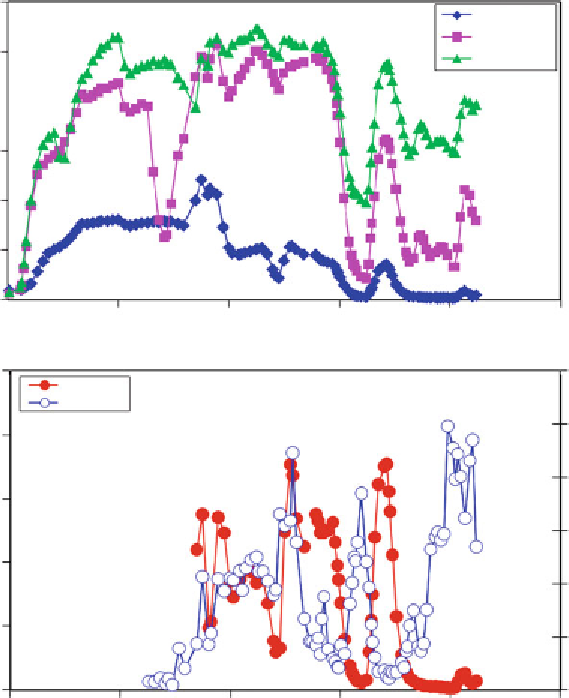Biomedical Engineering Reference
In-Depth Information
a
180
1,1-DCE
1,1-DCA
150
1,1,1-TCA
120
90
60
30
0
0
5
10
15
20
25
Time (days)
b
5
12
Butane
DO
10
4
8
3
6
2
4
1
2
0
0
0
5
10
15
20
25
Time (days)
Figure 8.7. Concentrations of CAHs (top) and butane and DO (bottom) at the east S1 monitoring
well during the first bioaugmentation and biostimulation experiment with the Rhodococcus sp.
butane enrichment culture at Moffett Test Facility (adapted from Semprini et al.,
2007a
). Bioaug-
mentation occurred on day 9 of the experiment.
The degree of treatment decreased as the experiment progressed. A modeling analysis of the
test results suggested that the loss of transformation performance was associated with 1,1-DCE
transformation toxicity and insufficient levels of the cometabolic substrate (butane) (Semprini
et al.,
2007b
). 1,1-DCE removal was restored when more butane was added to the treatment zone.
At the end of the 70-day trial, removals of about 94%, 8% and 0% were observed for 1,1-DCE,
1,1-DCA and 1,1,1-TCA, respectively. In the control leg, prolonged biostimulation removals of
86%, 5% and 0% were observed for 1-DCE, 1,1-DCA and 1,1,1-TCA, respectively. The test results
and associated modeling analysis indicated that the biostimulated microorganisms were gradu-
ally replaced by indigenous microorganisms that could transform 1,1-DCE, but had limited
ability to transform 1,1-DCA and essentially no ability to transform 1,1,1-TCA.
The results of the second season of field testing are provided by Semprini et al. (
2009
).
The study evaluated potential for cometabolism of 1,1,1-TCA through bioaugmentation with
a butane enrichment culture containing predominantly two
Rhodococcus
sp. strains

Search WWH ::

Custom Search